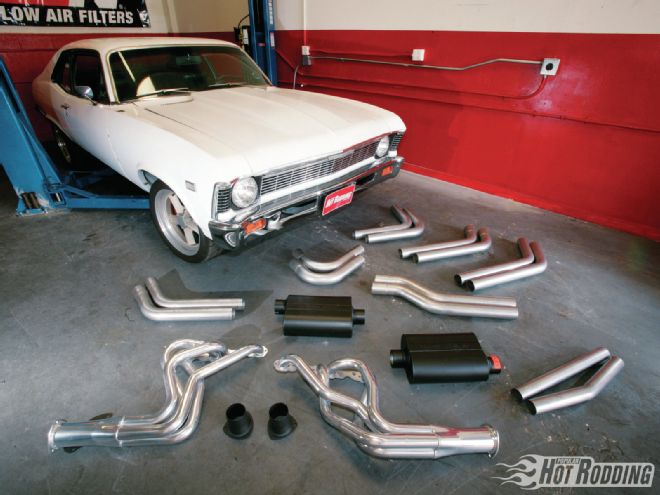
Big pipes and a throaty rumble are what street machines are all about, but it’s not just about the sound; an exhaust system has to perform up to the engine’s full capability, too. Compounding the issue is the expense involved of chasing down headers, mufflers, pipes, and, in some cases, the right tools. You’ll have a lot invested in your system—even if it’s really basic, like the one on our ’68 Nova. Bottom line: It pays to get it right the first time.
For Project Nova, we selected a set of Hooker Super Comp long-tube headers (PN 2207-1HKR). These are designed to fit ’68-74 Chevy Novas, and have 17/8-inch diameter primary tubes in a 30-inch length with a 3.5-inch collector. They also feature high-temp ceramic coating, which helps retain heat inside the header for more efficient exhaust scavenging. We will get into the mechanics and sizing of our header selection in the next Nova installment, but we’ll quickly mention that these pipes were calculated to maximize the torque of our stump-pulling Dart 400 SHP-based small-block.
The exhaust aft of the pair of Super Comp collectors is our objective this month, and was handled by the exhaust professionals at Automotive Excellence in Huntington Beach, California. AE proprietor Alex Mayea has been bending up serious hot rod exhausts for seven years, and has built pipes for nearly every kind of muscle car on the road. We knew we could trust Mayea with our Nova project after seeing some of the cool projects he’s worked on in his family owned shop, so we handed him the keys to work his magic on the Chevy.
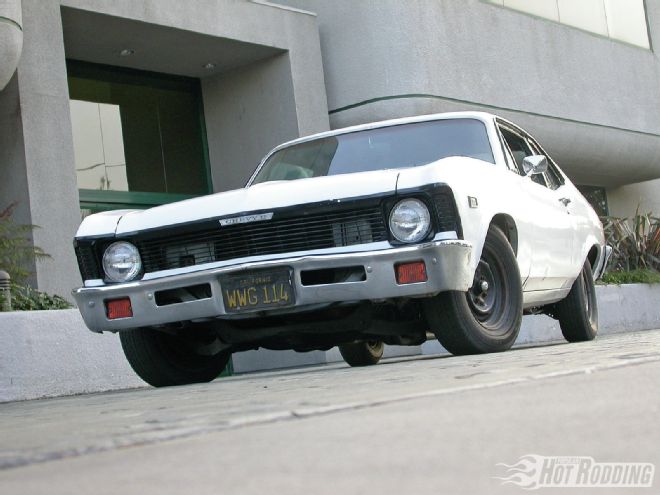
“The first thing people do is bend over and look at it from the side, so the first thing you notice is if one pipe is hanging lower than the other,” Mayea says. “We try to get that right. From a customer’s standpoint the two biggest concerns are rattling and leaks. Both of those are things we check before taking the car off the rack.” Mayea continues: “We did turndowns on this car, but most people would want tailpipes. Depending on the rearend and suspension, the tailpipes might need modifying. We can handle that, whereas a hobbyist might not be able to complete the install. Up to the mufflers, kits usually fit pretty good, but then the tailpipes can have issues.”
As a Flowmaster dealer, Mayea is well-versed in the product lineup, and agreed when we expressed an interest in keeping the Nova Flowmaster equipped. The ’68 had a basic 2-inch dual Flowmaster system on it when we bought it, as well as some undersized 1½-inch headers that were showing signs of age. Our take on it was that we liked the basic sound of this setup, but we needed something that would satisfy the flow requirements of the larger 400ci Dart small-block. With 523 hp at the crank, we were leaving a lot of sauce on the table, and a larger exhaust system would allow us to fully unleash the Dart’s fury.
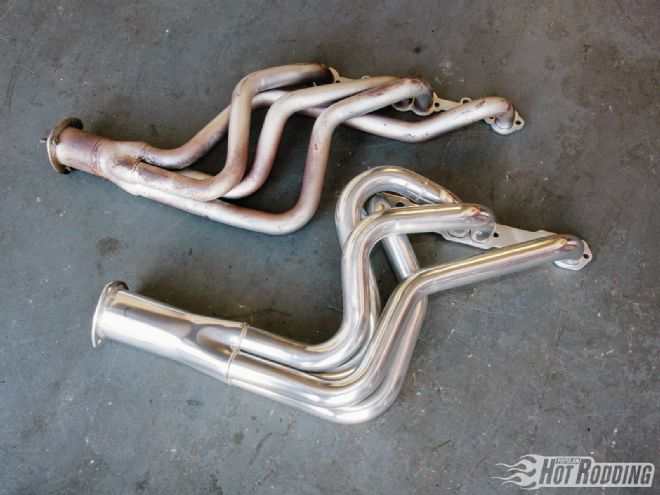 Note the comparative size of Project Nova’s original 1½-inch headers installed by a previous owner (top), and the new Hooker Super Comp ceramic headers with 17/8-inch primaries. Bigger isn’t always better, although too small will hurt performance—and that was our case here. With over 500 lb-ft of torque available from our 400ci small-block at 3,700 rpm, and 523 lb-ft peaking at 4,400 rpm, a bigger tube was called for. We’ll have more on the science of primary tube sizing next month when we dive into our header story.
Note the comparative size of Project Nova’s original 1½-inch headers installed by a previous owner (top), and the new Hooker Super Comp ceramic headers with 17/8-inch primaries. Bigger isn’t always better, although too small will hurt performance—and that was our case here. With over 500 lb-ft of torque available from our 400ci small-block at 3,700 rpm, and 523 lb-ft peaking at 4,400 rpm, a bigger tube was called for. We’ll have more on the science of primary tube sizing next month when we dive into our header story.
After studying the Flowmaster website and getting input from Mayea, we opted for the Super 40s. Mayea told us: “The two-chamber Super 40s definitely have a more powerful exhaust tone outside, but are quieter in the interior of the car. This is for a car that’s more of a driver, but that still needs an aggressive muscle car rumble on the outside.” That’s just what we were after, so we calculated our diameter at 2¾ inches for dual pipes (see chart on p. 68). Rounding up to the next available size, we chose a Super 40 with a 3-inch inlet/outlet diameter and an offset inlet (PN 953046). This should cover us easily to almost 700 hp should we want to add a blower, turbo, or nitrous somewhere down the line.
Complementing the Hooker Super Comp headers and Flowmaster Super 40s would be Flowmaster’s universal U-Fit 3-inch dual pipe kit, which AE would adapt to our Nova chassis using the 3.5- to 3-inch collector adapters included in the Hooker header kit. We really liked the sound of the axle turndowns from the existing system, so for the new system AE replicated those by sectioning one of the mandrel bends from the U-Fit kit.
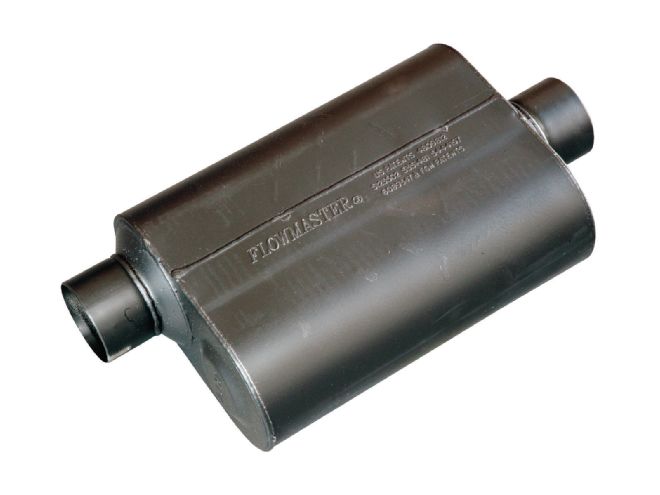 Flowmasters are used on some of the country’s most powerful race cars, and we wanted some of that mojo for the Nova. The Super 40 (PN 953046) has a 3-inch inlet/outlet, a 5-inch-thick body, and a case that’s 13.5 inches long by 10 inches wide. The offset inlet will prevent any driveshaft interference. Alex Mayea of Automotive Excellence says: “The two-chamber Super 40s definitely have a more powerful exhaust tone outside, but are quieter in the interior of the car. This is for a car that’s more of a driver, but that still needs an aggressive muscle car rumble on the outside.”
Flowmasters are used on some of the country’s most powerful race cars, and we wanted some of that mojo for the Nova. The Super 40 (PN 953046) has a 3-inch inlet/outlet, a 5-inch-thick body, and a case that’s 13.5 inches long by 10 inches wide. The offset inlet will prevent any driveshaft interference. Alex Mayea of Automotive Excellence says: “The two-chamber Super 40s definitely have a more powerful exhaust tone outside, but are quieter in the interior of the car. This is for a car that’s more of a driver, but that still needs an aggressive muscle car rumble on the outside.”
We’ve yet to make it to the chassis dyno, but we plan to do that down the line when we experiment with FAST’s new EZ EFI throttle-body fuel injection system. We’ll be doing some before/after dyno testing with back-to-back runs of carb versus EFI, plus we’ll have some online video clips to show you how the Nova sounds at wide-open throttle. Next month, however, we’ll show you some really cool pieces from Hooker that allow you to easily modify header primary tubes around underhood obstructions. Mayea and the crew at AE did such an excellent job modding our Hookers, we dare you to tell the difference! Be sure to check it out next month here in PHR.
So How Does It Sound?
Go to www.popularhotrodding.com and check out the video of Project Nova as we put the new Hooker/Flowmaster system through a thorough sound check!
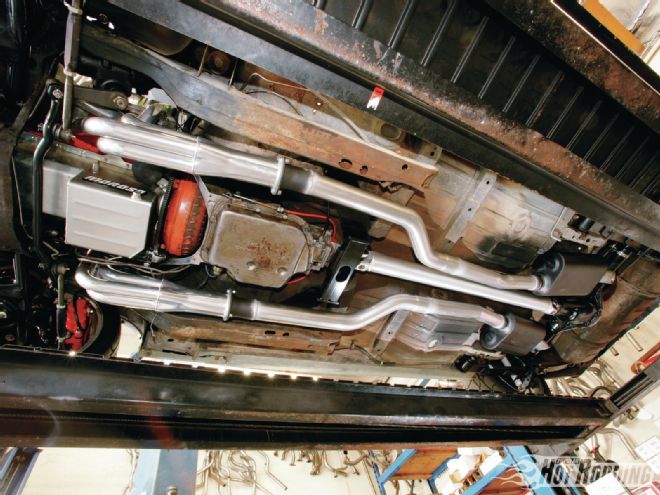 Treated with high-temp silver paint around the weld surfaces and mounted back up on the car, the fully welded Flowmaster 3-inch dual system is ready to rock. The sound with axle turndowns is simply amazing, both at cruise speed and at full throttle!
Treated with high-temp silver paint around the weld surfaces and mounted back up on the car, the fully welded Flowmaster 3-inch dual system is ready to rock. The sound with axle turndowns is simply amazing, both at cruise speed and at full throttle!
DIY vs. A Good Shop
We opted to use the services of Automotive Excellence in Huntington Beach, California, but assembling a custom exhaust system like ours is well within the reach of the average guy, provided you’ve got the right tools. Assuming you already have a serviceable MIG welder, a compressor, jackstands, and all the normal stuff, you can expect to buy a few specialty tools for a job like this. We priced out some super affordable tools from the DIY experts at Harbor Freight that will provide similar functions to the pro tools at AE. The comparison works out like this: AE charges about $300 in labor for a job like this. You get to watch from the sidelines while the pros do it, but you won’t gain much personal experience. Buying the tools yourself, however, will give you the satisfaction of doing it yourself, while rounding out your tool collection.
Exhaust System Sizing
It’s possible to mathematically calculate the flow requirements of an exhaust system based on the total mass flow of the system (mass of the ingested air plus the mass of the fuel), but it works out to about 2.2 cfm per engine horsepower. For a straight piece of round pipe, each square inch of cross-sectional area flows about 115 cfm, so it’s a matter of working forward from there. This handy chart takes most of the math out of sizing an exhaust system, and from this you can see that our 532hp Dart small-block breathes nicely with a dual 3-inch system.
PIPE DIA.:
PIPE AREA (IN2):
TOTAL CFM
MAX HPPER PIPE:
MAX HP(DUAL SYSTEM)
1½
1.48
171
78
155
1⅝
1.77
203
92
185
1¾
2.07
239
108
217
2
2.76
318
144
289
2¼
3.55
408
185
371
2½
4.43
509
232
463
2¾
5.41
622
283
566
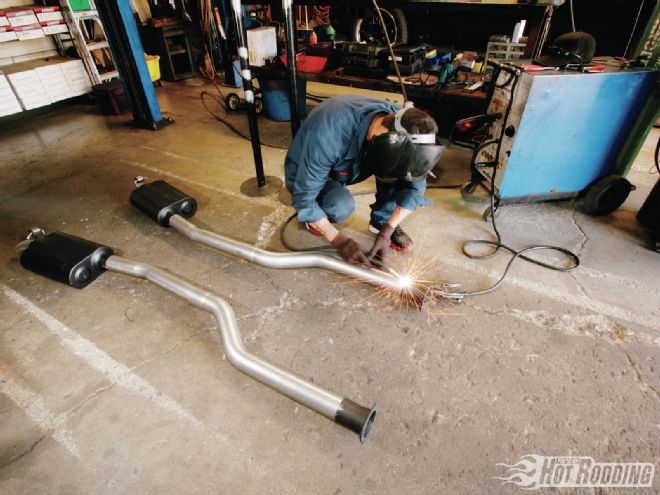 With the Flowmaster U-Fit pieces, Super 40 mufflers, and Hooker collector adapters tack welded in place, Mayea removed the system from the Nova to make the final welds. Mayea set the Millermatic 35 to 4 amps current and the wire feed speed to between 40 and 45 inches per minute, using .035-inch wire. “You don’t want too much heat or you will blow a bunch of holes. You also need a really good ground connection,” Mayea says. Some Miller MIGs have Auto-Set, which only requires the user to set the material thickness (16 gauge in this case) and the wire thickness. Amperage and wire speed are automatically set.
With the Flowmaster U-Fit pieces, Super 40 mufflers, and Hooker collector adapters tack welded in place, Mayea removed the system from the Nova to make the final welds. Mayea set the Millermatic 35 to 4 amps current and the wire feed speed to between 40 and 45 inches per minute, using .035-inch wire. “You don’t want too much heat or you will blow a bunch of holes. You also need a really good ground connection,” Mayea says. Some Miller MIGs have Auto-Set, which only requires the user to set the material thickness (16 gauge in this case) and the wire thickness. Amperage and wire speed are automatically set.
Tools You’ll Need Description: Source: PN: Price 16-ton Central Hydraulics pipe bender, 3-inch capacity Harbor Freight 35336 $169.99 Chicago Electric heavy-duty cutoff saw, 14-inch blade Harbor Freight 91938 $69.99 U.S. General large tailpipe expander Harbor Freight 37354 $14.99 Total: $254.97
Where The Money Went
Item:
Source:
PN:
Price:
U-Fit Dual 3-inch pipe kit
Flowmaster/Summit
15937
$259.95
Super 40 Series Delta, 3-inch inlet/outlet
Flowmaster/Summit
953049
$89.95 ea.
Super Comp headers, 17/8-inch dia.
Hooker/Summit
2207-1HKR
$755.95
Southern exhaust hangars
AE/Nickson
FW 913L
$2.50 ea.
Total:
$1,200.80